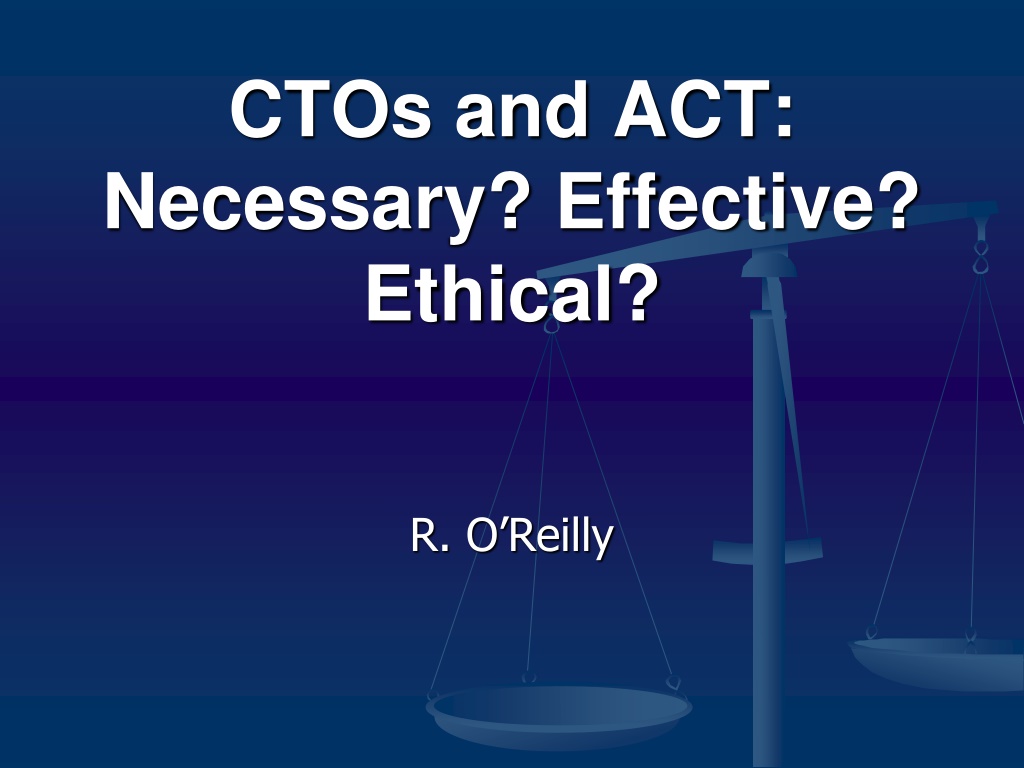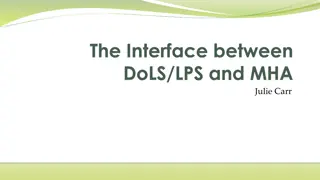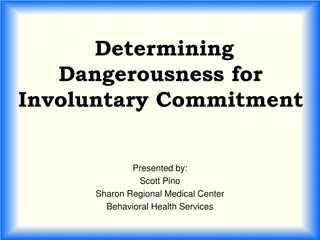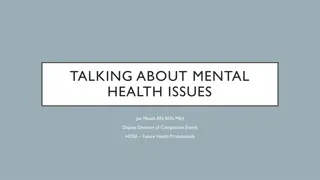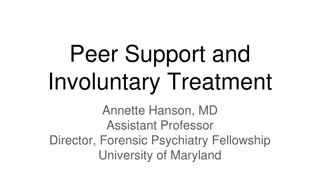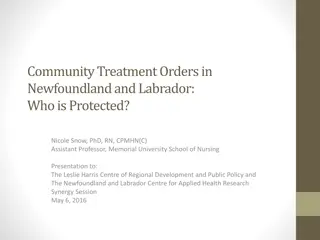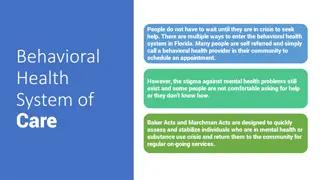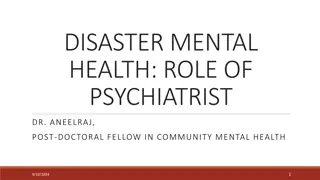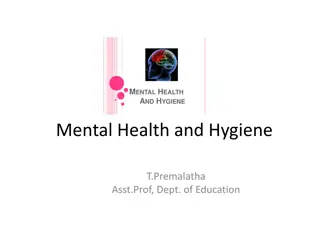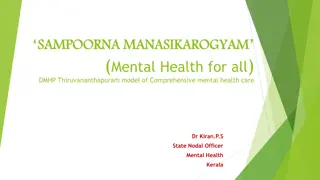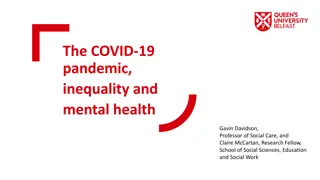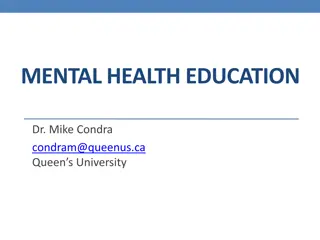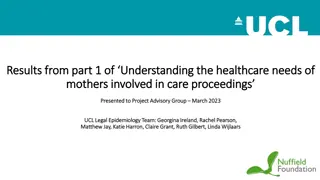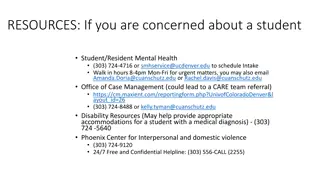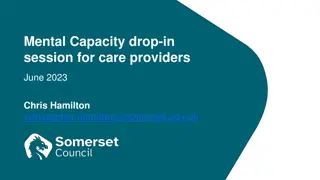Understanding the Role of CTOs and ACT in Mental Health Treatment
Exploring the necessity, effectiveness, and ethical considerations surrounding Community Treatment Orders (CTOs) and Assertive Community Treatment (ACT) in mental health care. Examining the need for CTOs, their effectiveness, comparison between CTOs and ACT, suitable patients for CTOs, care and treatment under CTOs, and the duration of CTOs. Reviewing research on CTOs and ACT, their impact on patient outcomes, and alternatives to CTOs.
Download Presentation

Please find below an Image/Link to download the presentation.
The content on the website is provided AS IS for your information and personal use only. It may not be sold, licensed, or shared on other websites without obtaining consent from the author. Download presentation by click this link. If you encounter any issues during the download, it is possible that the publisher has removed the file from their server.
E N D
Presentation Transcript
CTOs and ACT: Necessary? Effective? Ethical? R. O Reilly
Why we need CTOs Do they work? Is ACT an alternative to using CTOs? Review of ACT and CTOs Which patients are suitable for a CTO? What care and treatment under a CTO? How long should a CTO last?
Why Do We Need CTOs? Deinstitutionalization is a massive public policy experiment Deinstitutionalization is relocating the locus of treatment to the community The authority to treat in hospital settings must be extended to the community
Do CTOs Work? Three randomized controlled trials New York North Carolina England & Wales Some case-controlled studies Many before-and-after studies A few studies using data-bases
Is ACT an alternative to CTOs? If we had sufficient services would not need CTOs Not when there is outright refusal of Rx Not when ACT alone has failed because of non-adherence to Rx Should we try ACT alone first? CTO can dispense with repeated cajoling CTO has more procedural justice CTO renewals can reignite irritation
North Carolina RCT Less 3 services per month
North Carolina RCT More 3 services per month
Typical use of ACT and CTOs London, Ontario Average Range 17% 10-30% Indiana State Median Range 16% 0-65% Moser 2009
Research on ACT and CTOs CTO & ACT compared with ACT alone Doubled engagement with services Halved hospitalization Swartz 2010 > medication adherence & < admissions after CTO ended: CTO < 6 months needed ACT CTO > 6 months persisted without ACT Van Dorn 2010
ACT, CTOs and Coercion CTOs increase perception of coercion ACT does not increase perceived coercion No addition when CTOs & ACT combined Galon 2011
London ACT/CTO Study Did you use ACT alone before adding CTO Yes No No response 57% 40% 3%
Reasons ACT Insufficient Patients refused medication Patients unavailable for Rx and F/U CTO recall powers necessary for timely Rx Patients had violent potential or Hx
Who is Placed on a CTO? There is remarkable consistency in the characteristics of patients on CTOs across jurisdictions embedded in very different cultural and geographical settings. The descriptive data indicate that patients are typically males, around 40 years of age, with a long history of mental illness, previous admissions, suffering from a schizophrenia-like or serious affective illness, and likely to be displaying psychotic symptoms, especially delusions, at the time of the CTO. Criminal offences and violence are not dominant features amongst CTO patients. This picture is largely reinforced in the comparative data, which suggest that CTO patients are more likely to be severely mentally ill with high hospital admission rate histories, poor medication compliance, and aftercare needs. The Churchill Report 2007
Who Should be on a CTO? ~Geller s Criteria~ Wants to leave hospital Previously failed in community Understands treatment order Can comply Not dangerous if complies Treatment previously effective Treatment meets the patient s needs and can be delivered by system Treatment can be monitored Outpatient system must be willing partner Inpatient system must be willing partner Geller 1990
Who Does Well on a CTO? Patients refusing Rx who can be convinced Patients with high probability of default Patients who lack insight (incapable) Patients who respond to the treatment Patients with psychotic disorders Patients on long-acting injections Those without Cluster B personality disorder
Who is suitable for a CTO? ~North Carolina RCT~ Patients with psychotic disorders who were placed on a CTO for > 6 months showed a 72% decrease in hospitalization In contrast, patients with affective disorders on CTO for > 6 months disorders showed no decrease
Why Psychotic > Mood? Most mood disorder patients fully recover Most mood disorder patients have insight More mood disorder patients have PD? Mood disorder patients take oral meds
What Care and Treatment? Medication Clinical monitoring Stable residence Laboratory tests Counselling/therapy Refrain from substances
The Importance of Medication 50% of patients with schizophrenia lack insight Amador et al 1993 74% of patients with schizophrenia non- adherent within 2 years of discharge Weiden & Olfson 1995 When LAIs stopped in 1st episode patients, 78% relapsed within 1 year and 96% within 2 years Gitlin et al 2001 Mortality increased X 12 after stopping meds Tiihonen et al 2006
Long-acting Injections Modest evidence for superior effectiveness Naturalistic studies stronger than RCTs Zhornitsky & Stip 2012 Better treatment adherence independent of being on a CTO Swartz et al 2001 NSW < admissions on CTO with depot vs. oral Vaughan et al 2000
Specifying Residence on a CTO Treatment can be monitored Geller 1990 Observe medication Daily monitoring of symptoms Nighttime supervision Limits drug use Three square meals
Specifying Residence on a CTO PG&T will give consent The individual will reside in a group home or residential setting which, by program design, supports the development of life skills and promotes treatment adherence CCB has upheld the practice Case of Ms. MBG July 2003
Laboratory Tests Monitoring mood stabilizers Tests for specific medical indications Segal 2006 Kisely 2013 Screening for drugs of abuse
What Care and Treatment? Medication Clinical monitoring Stable residence Laboratory tests Counselling/therapy Refrain from substances
How Long Should a CTO Last? North Carolina study reported positive outcomes when CTO was continued > 6 months Actually found that the longer the CTO, the better the outcomes Swartz et al 1999 New York study also suggests 6 month minimum Van Dorn 2010 Iowa study average duration was 4.5 years Rohland et al 2000
